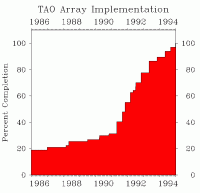Building TAO
Development of the Tropical Atmosphere Ocean (TAO) array was motivated by the 1982-1983 El Nino event, the strongest of the century up to that time, which was neither predicted nor detected until nearly at its peak. The event highlighted the need for real-time data from the tropical Pacific for both monitoring, prediction, and improved understanding of El Nino. As a result, with support from NOAA's Equatorial Pacific Ocean Climate Studies (EPOCS) program, PMEL began development of the ATLAS (Autonomous Temperature Line Acquisition System) mooring. This low-cost deep ocean mooring was designed to measure surface meteorological and subsurface oceanic parameters, and to transmit all data to shore in real-time via satellite relay. The mooring was also designed to last one year in the water before needing to be recovered for maintenance.
Under the direction of PMEL scientist Stan Hayes, prototype ATLAS were field tested in early 1984, and a modest scale array was deployed along 110W in late 1984. Additional ATLAS deployments were made beginning in 1985 at the start of the 10-year (1985-94) international Tropical Ocean Global Atmosphere (TOGA) program. The array, named the Tropical Atmosphere Ocean (TAO) array, grew slowly during the first half of TOGA as the proof of concept for a sustained buoy observing system was evaluated. Initial successes led to a rapid expansion of the array during the second half of TOGA with the widespread support of the climate community.
The full array of nearly 70 moorings was not completed until the final month of TOGA (Dec 1994). During the 10 years in which the array was under development, over 400 buoys were deployed on 83 cruises, using 17 different ships from 6 different countries. Accomplishing this feat required a multi-national partnership of institutions in the US, Japan, France, Taiwan, and Korea.
After TOGA ended in 1994, the TAO array continued under sponsorship of the international Climate Variability and Predictability (CLIVAR) program, the Global Ocean Observing System (GOOS), and the Global Climate Observing System (GCOS). In 1996, the NOAA Ship KA'IMIMOANA was commissioned to service the TAO array east of 165E. In 1997, the US Congress authorized long term sustained support of the TAO array as part of an operational El Nino/Southern Oscillation (ENSO) observing system. On 1 January 2000, the TAO array officially became the TAO/TRITON array, with sites west of 165E occupied by TRITON (Triangle Trans Ocean Buoy Network) buoys maintained by the Japan Agency for Marine-Earth Science and Technology (JAMSTEC).
The operationally supported measurements of the TAO/TRITON array consist of winds, sea surface temperature, relative humidity, air temperature, and subsurface temperature at 10 depths in the upper 500 m. Five moorings along the equator also measure ocean velocity. Additional moorings and/or enhancements to the basic measurement suite are often incorporated to the operational array in support of research studies to understand specific physical processes not well measured by the existing network. Other measurements may be made for satellite or numerical model validation purposes. These research efforts are usually of limited duration and/or geographical scope, and done in collaboration with other institutions in the US and abroad.
To meet the demands of both operational and research measurements in the TAO array, an engineering redesign of the ATLAS was initiated in 1994 to update it with greater measurement capabilities, improved ocean temperature sensor accuracies, and more modular construction. The Next Generation ATLAS now has the capability to measure and transmit in real-time salinity, rainrate, long and shortwave radiation, barometric pressure, and ocean velocity. These measurements are made at selected sites to meet the needs of specialized research experiments. A robust high-latitude version of the ATLAS mooring has also been designed, capable of deployments for up to one year in the more energetic oceanic regimes of the extratropics.
The TAO/TRITON array is currently supported by the US (NOAA), Japan (JAMSTEC), with additional contributions from France (IRD).



